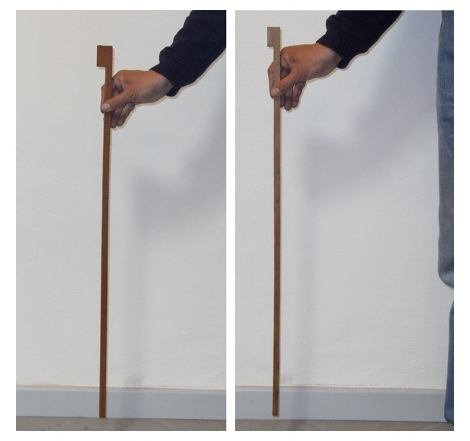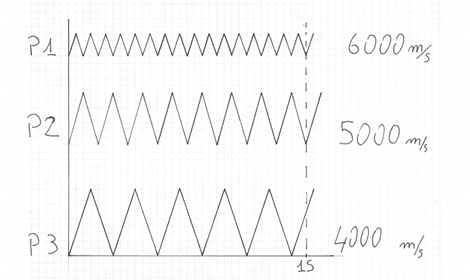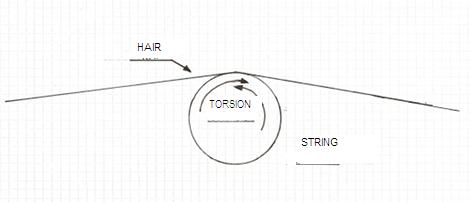THE RESONANCE FREQUENCY
As advanced in the previous blog, one of the positive aspects of the high sound velocity we can find in a material, is that to this parameter corresponds a very high resonance frequency. This week , using practical examples, I will try to explain why this parameter is so important.

It is very difficult to explain in few words why the resonance frequency may be of great importance but you may rest assured that, if you will be able to carry out the same test I am showing you in the pictures and if you own a musical ear, you will need no words any more. The two pernambuco sticks I am testing have a very different sound velocity: the first one measures 3800 m/s, the second one more than 5900 m/s. (keep in mind that pernambuco can rarely go beyond 6000 m/s). It is sufficient to keep them in hand and then let fall them down on the ground from a distance of two/three cm so to realize the importance and correctness of this parameter.
The output sound is very different: the first stick will give a low, dark sound that lasts a short time, while the second sound will be very high, crystal clear and will last longer.
It will be the same sound you will obtain beating with a coffee spoon both a steel plate of reduced thickness and a crystal glass.
I know that not everyone has pernambuco sticks at home but if you will drop by in my workshop, I will be glad to show it to you personally, furthermore you can carry out the same test on several materials in order to ascertain their resonance frequency.
These two parameters, the fibers tension and the resonance frequency, that as we could see are directly proportional, affect both sound and mechanical performance of the bow.
For several reasons, the sound effect is that one that, absurdly, can be perceived with a greater difficulty. The explanations of this difficulty may be splitted mainly in two different ways. The first one and the easiest to understand is when a musician plays in a theatre he cannot be at the same time also at the opposite corner of the concert hall just to listen how the sound arrives over there, he is not ubiquitous !
The second explanation is psycho-acoustic.
For instance, if the player uses to play with a poor bow with a so called “smooth” sound, what he will hear with a good level bow, will be totally different from what he already knows, so he will be disoriented. If you join this way to judge a bow sound and the fact that who plays cannot listen to it at the same time, induce confusion in the player who has to choose a bow and often he doesn’t choose the most proper one.
The sound of a bow, when made with a wood owning a high sound velocity, will be clear
and homogeneous if listened by the player and it will give a stiff sensation, especially when played with it for the very first time. You have to take care of a particular thing while testing a bow.
Try not to hear the sound but from where the sound derives; when the wood of a bow is of a poor quality, maybe the sound will be a smooth one but the sound with not come out from the inside part of the instrument but it will will give you the sensation that it comes from the harmonic plate. On the contrary, if the wood is a good one, the deepness of the sound will increase allowing you to hear the case of the instrument.
This phenomenon can be explained by the higher tension of the strings that stimulates the instrument a lot and allows a higher quantity of natural harmonic of the fundamental. The higher the stimulated harmonic , the clearer and more defined the sound will be. The only counter-indication is that with such a clear sound, every intonation defect can be easily detected, so if you place a finger in a wrong position you will not be forgiven. Even if you are not able to understand the sound nature at once, you will be impressed at once by the mechanic of a bow made with a good wood.

This very simple graphic compares three material owning very different sound velocity properties. As you can see when the velocity decreases, the vibrations on the fiber become less frequent and they open up sharply, affecting both sound and mechanic.
With the first (P1) you would be able to launch the sound very far with a small effort letting each note to be heard, with the second one (P2) even with big efforts, the sound will not go farther than the third row and it would be difficult to understand what you are doing, while with the third one (P3) you will have no possibility to play at all.
The mechanical effect are not very different. When the vibrations decrease, the specific strength will go down as well, therefore the bowmaker should have to make a very heavy bow to get the same resistance in a very elastic material and, even if he is a good craftsman and manages to make a usable bow out of it, the result will be not sufficient as it will come from a inert mass.
Other two parameters that can be affected by a high decrease of the sound velocity are the agility and the keeping of the sound.

To understand this effect, it is necessary to understand how a string works. When you pull a bow, the string is alternatively stimulated, or better, you submit it to a torsion in the direction you are going to and then it comes back. The bow takes and releases the string continuously and at a higher frequency of the vibrations correspond a higher continuity and sound keeping.
To let you better understand, I will end this topic with an example that M° Lucchi uses to tell and I take the opportunity to thank him personally and by all people working in my field because he introduced a basic parameter as the sound velocity in the bowmaking and this gave a fantastic impulse to the evaluation of the material to make bows. Maybe just few of you know what the “hurdy gurdy” is.
The hurdy gurdy is a string instrument with a very particular mechanism able to produce sound. The strings of this instrument vibrate by mean of a wheel covered with leather. The wheel touches the string tangentially and, by rotating, it gives origin to a continuous sound. Imagine for a while to have plectrums instead of leather. If they are numerous and thick, you will get a continuous sound (P1), if they are rare (P2) an uneven sound and if you just have one (P3) you better take a walk and have coffee because before hearing the next “deng” you have to wait a whole turn.
So long
Paolo.
|